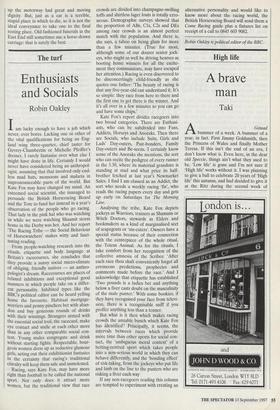Not motoring
Genius for ceremony
Gavin Stamp
And in those two months, an extraordi- nary 'funeral car' was designed and built. Prince Albert did not think much of what William Banting, the royal undertaker, pro- posed, so the job was turned over to the new Government Schools of Design then in Marlborough House under the direction of Henry Cole, the future secretary of the South Kensington Museum (now the V&A). There, a car was created by Richard Redgrave and was made largely of bronze from French cannon captured at Waterloo: `a real substantial work ... thoroughly sim- ple, as was the character of the Duke, the only decorations being the pall, the armori- al bearings .. . and the names of his great battles'. In fact, it was very elaborate indeed, with a richly sculptured chassis and six huge, solid, decorated wheels. And it was 27-feet long, 10-feet wide and 17-feet high — dimensions limited only by the necessity to get through the arch of Sir Christopher Wren's Temple Bar (since removed to Theobald's Park). This colossal object was made in a mere three weeks, with the female art students being responsible for the embroidered pall which covered the Iron Duke's coffin. On the appointed day, the great juggernaut left Horse Guards pulled by 12 black dray hors- es supplied by Booth's Distillery, and up to one and a half million people watched as it was hauled up to Hyde Park Corner and then along to St Paul's. This took two and a half hours, mainly because this unwieldy vehicle was not quite as functional as Prince Albert and Henry Cole had hoped. Weighing 18 tons, it dug into the road and got stuck in both the Mall and Ludgate Hill. And when it eventually arrived at the cathedral the swivelling mechanism for the coffin did not work so that the great west doors remained open for an hour and a half before the funeral could begin. When the Iron Duke was finally interred, nobody could think what to do with the wretched car. Eventually, it was put in the crypt of St Paul's but this triumph of British design can now be seen at Stratfield Saye.
The vehicle which bore the pickled body of the Victor of Trafalgar to St Paul's almost half a century earlier was rather smaller, and more successful. It was the creation of Rudolph Ackermann, that most enterprising publisher who had begun in Germany as a carriage designer. His four- wheeled Grand Funeral Car was given a prow and a stern like those of H.M.S. Vic- tory while Viscount Nelson's coffin was cov- ered by a Grecian plumed canopy supported on four palm-tree columns — a tribute to his victory at the Battle of the Nile. Drawn by six black, plumed horses, Ackermann's car took Nelson from the Admiralty to the City without incident on 9 January 1806.
Alas, this charming, exotic funeral car was not preserved, but it was not forgotten and a curious tribute was paid to it a centu- ry later. For in his Surrealist transforma- tion of Monkton House in Sussex in the late 1930s, Edward James not only installed padded walls and Salvador Dali's 'lips' sofas but also made himself an extraordi- nary four-poster bed with palm tree columns — and this was inspired by Nel- son's funeral car and not Napoleon's, as is often stated.
Not that Bonaparte's was anything ordi- nary. The canopied carriage which took his body to the grave on St Helena was simple enough, but when Louis-Philippe tri- umphantly brought his remains back to Paris in 1840 no holds were barred. The Emperor's ashes were in a casket support- ed by a bevy of 14 voluptuous caryatids who stood above a car decorated with a strange mixture of imperial wreaths and eagles and suits of armour. The whole thing was designed by Henri Labrouste, the future architect of the Bibliotheque Genevieve. Festooned with a transparent veil of black crepe, this fantastic, top-heavy, 11-metre-high, four-wheeled juggernaut was hauled by sixteen horses dressed in white along the Champs Elysees past deco- rations by Louis Visconti, the architect who would create the pilgrimage tomb under the dome of the Invalides soon after.
Mere queens and princesses, of course, must make do with more prosaic vehicles. It was Queen Victoria who began the tradi- tion of mounting the coffin on a gun car- riage. In her case, she was brought from Osborne first by battleship, then by train from Portsmouth, then across London on a gun carriage covered by a white satin pall, then on the Great Western to Windsor hauled by a wreath-laden engine. But Mr Beeching, amongst others, made it difficult for the poor Princess of Wales to return to Althorp by train, and I must say that the flower-covered motor hearse driving slowly up the motorway had great and moving dignity. But, just as a car is a terrible, stupid place in which to die, so it is not the ideal conveyance to take one to the final resting place. Old-fashioned funerals in the East End still sometimes use a horse-drawn carriage: that is surely the best.



































































 Previous page
Previous page